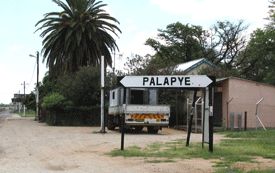Our heitage
SANDY GRANT | Thursday January 10, 2013 00:00


Palapye, most spectacularly, demonstrated both. Such has been the extent of change that I completely missed the old road to the station and hotel and ended coming at them from the wrong side of the track. What an uncanny experience! All too clearly the old Palapye of the Shaws and Freemans has been completely shut off from the new.
The formerly bustling railway station, once the centre of the town, was lifeless, and its lovely old building now encased within a hedge and hidden well out of sight appeared to be little more than a private dwelling.The hotel was much as it always was, and in need of an overhaul which its current situation is unlikely to justify. Nearby was the still just recognisable old pavilion, once the pivot of 'white' Palapye's social life as it played tennis and cricket in an area now dotted with thorn bushes. Nearby used to be Mma Shaw's ingenious rondavel house, her Mess where billiards were once played, and the home of Thomas and Barbara Shaw. Not having been there for years it was inevitably disconcerting to find that what had survived the flood and the passing years, had been swallowed up by what is now the Itumela camp which states curiously that it is located in Palapye Village. Perhaps the designation is a deliberate attempt to distance the old railway settlement area from the brash and not entirely attractive new town.
Is it possible for new towns to be attractive or are they inevitably characterised by uncontrollable commercial blight? Is commercial blight an inevitable part of the change that occurs when a village develops into a townModern Palapye, for instance, as we drive through it from south to north, is about as charmless as it is possible to get. Tlokweng, as it is approached from the border, is not much better.
Somehow Mahalapye, however, has contrived to escape the blight and appears tidy and attractive. Mmadinare too gave the impression of being well-organised, clean and affluent. Bobonong on the other hand, appeared to be not only a bit of a disaster but unlike anywhere else in the country - certainly anywhere with which I am familiar.
For reasons which someone will helpfully explain, it also appeared to be the uncontested national donkey capital with donkeys throughout the area being far more visible and numerous than cattle. As a town, Bobonong was bare, bleak, and littered.
When there is a strong wind, the place must be unbearable. It's one distinguishing feature, Khama's brick built church of 1918, occupies probably the town's one commanding site but is now so surrounded by private homes that it can be approached only by a narrow corridor. Bleakness is a characteristic which Bobonong does, however, share with the much smaller Serule which, over the years seems to have changed very little. Apologies to those for whom it is home, but it would come top of my list of places in which I would least wish to live.
